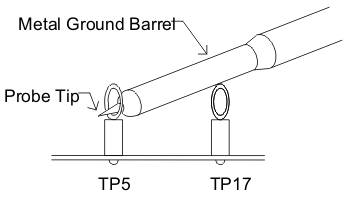SLUU535A September 2011 – January 2022 TPS40400
- 1 Introduction
- 2 Description
- 3 Electrical Performance Specifications
- 4 Schematic
- 5 Test Setup
- 6 EVM Configuration Using the Fusion GUI
- 7 Test Procedure
- 8 Performance Data and Typical Characteristic Curves
- 9 EVM Assembly Drawing and PCB Layout
- 10List of Materials
- 11Revision History
5.2.4 Oscilloscope
A digital or analog oscilloscope can be used to measure the output ripple. To measure output ripple, the oscilloscope should be set for 1-MΩ impedance, 20-MHz bandwidth, AC coupling, 2-µs/division horizontal resolution, 50-mV/division vertical resolution. As shown below in Figure 5-1, test points TP5 and TP17 can be used to measure the output ripple voltage by placing the oscilloscope probe tip through TP5 and holding the ground barrel to TP17. It is not recommended to use a leaded ground connection because this may induce additional noise due to the large ground loop.
To measure other waveforms, adjust the oscilloscope as needed.
 Figure 5-1 Tip and Barrel Measurement for VOUT Ripple
Figure 5-1 Tip and Barrel Measurement for VOUT Ripple